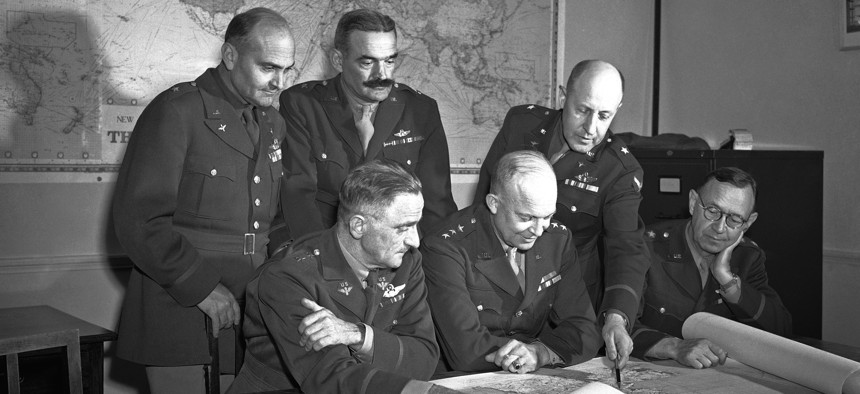
These six U.S. generals, who are directing the operations of U.S. forces from Great Britain check over a map during a conference on August 19, 1942. AP Photo/Jack Rice
Trump Needs Help Picking Between His Contradictory Foreign-Policy Desires
Unfortunately, not even a 21st-century version of Eisenhower’s Solarium planning exercise is likely to help.
President Donald Trump doesn’t get enough appreciation for the fact that the national-security policies he campaigned on, he is carrying out: withdrawing from the Trans-Pacific Partnership and the Iranian nuclear deal; renegotiating nafta; trying to have good relations with Russia; resetting the rules of international institutions, agreements, and relationships, including getting tough on allies. What he said he would do, he has largely done.
What his administration has not done is align its policies so that they are mutually supporting. The Trump-administration policies are contradictory, and undercut one another to an extent that verges on professional malpractice. So, for example, Trump bewails German dependence on Russian gas with respect to Germany’s participation in the Nord Stream 2 Pipeline while insisting we need better relations with the Russians, while withdrawing from the INF Treaty over bitter Russian objections, while expecting Russian support for more draconian sanctions against Iran, while insisting Russia continue “maximum pressure” against North Korea, while declaring his love for Kim Jong Un.
What this president desperately needs is a process for prioritizing and de-conflicting his objectives, determining the means to apportion to them, and developing strategies for aligning the ends, ways, and means. In other words, a strategic-planning exercise. Senator Ben Sasse of Nebraska gallantly offered the administration the very tools it needs, in the form of a provision of the Defense Authorization Bill requiring the president to conduct a “Project Solarium” on cyber. Solarium was a 1953 strategic-planning exercise undertaken by the Eisenhower administration, generally considered the zenith of American-government strategizing. Experts on the process of national-security policy are near-unanimous in their admiration of it.
Unfortunately, it is unlikely the Trump administration will take up the offer. Having only recently produced its National Security Strategy (which is supposed to do the same thing), the White House will be disinclined to repeat the process, especially in a group the legislation stipulates will be selected by Congress. While the president’s signing statement for the defense bill didn’t directly address the Solarium proposal, it rejected other, similar commission proposals.
But there’s another reason to think a Project Solarium unfortunately won’t succeed in a Trump administration. Solarium solved a problem President Dwight Eisenhower desperately needed to solve, which was bringing a rebellious and politically independent Cabinet and political party to heel. For all the adulation it receives as a national-security process, Solarium was a nakedly political exercise. It was the means Eisenhower used to lever independent political forces into supporting his policy. With a complacent Republican Congress and a loyal Cabinet, Trump has no similar problem, and therefore is unlikely to allow such a process to meaningfully bind him.
President Eisenhower faced a daunting problem. He was a celebrity politician well to the left of his party on national-security issues. Eisenhower’s service as the Allied commander in wartime Europe, and later as nato’s first commander, left him popular, but many party elders considered him a manipulable novice. Eisenhower reciprocated Republican leaders’ disregard, calling them “the most ignorant people now living in the United States.”
The objections weren’t simply personal; they reflected real policy differences. The 1952 Republican platform accused the Truman administration of having “lost the peace so dearly earned by World War II. The moral incentives and hopes for a better world which sustained us through World War II were betrayed, and this has given Communist Russia a military and propaganda initiative which, if unstayed, will destroy us.” The platform advocated purging the State Department, ending the policy of containment, rolling back Soviet influence, and reclaiming China for the free world.
Eisenhower needed to establish his authority over the Republican Party, in Congress and even in his own Cabinet: John Foster Dulles, who became secretary of state, was a leading advocate of the rollback policy and had written the Republican Party platform. Like the able bureaucrat he had long ago proved himself to be while managing the conflicting demands of wartime alliances, Eisenhower utilized the ostensibly neutral mechanisms of the policy process to achieve that aim.
Soon after his election, the president convened a pantheon of experts—including George Kennan, author of the famous Long Telegram on the Soviet Union—organizing them into competing teams to make their best cases in favor of three different policies for managing the Soviet threat. The problem was clearly defined by Eisenhower: America’s nuclear advantage over the Soviet Union was quickly diminishing; how do we best use the time remaining?
Team A, led by Kennan, argued for a continuation of the Truman administration’s policy of long-term resistance centered on Europe and utilizing political solidarity with allies and the attraction of economic improvement. This was, at its core, the Truman strategy, sheared of some of its sharper edges. This team’s biggest concern was not a Soviet Union armed with nuclear weapons, but the decline of confidence in the United States by other countries. It envisioned what we now call the rise of the rest, arguing for the inspirational power of American example to attract other countries to the Western model.
Team B made the case for relying less on allies and more heavily on nuclear weapons to deter and contain the Soviets. Scorched by the Truman administration having drawn a defense perimeter that excluded Korea, it acknowledged that “we could find no close-in line that was at all satisfactory,” meaning the threat of nuclear-weapons use must be universal. Team B conceded that it would be difficult to sustain allied support for the policy, so that unilateral options would need to be developed.
Team C assessed that Soviet power “will not fall apart, but must and can be shaken apart.” It advocated accepting greater near-term risk and engaging in clandestine warfare to pry captive states from Soviet grasp and foment regime change in China. It advocated “resorting to a ‘hard’ policy when required” toward allies: “Our task is to command respect, not necessarily love and devotion.” It concluded that “such a strategy would, while not designed to provoke war, accept a substantial risk of war, wherever justified by the gains to be achieved.”
The teams produced sharp analyses that assessed their respective implications across the near, medium, and long terms. They included resource requirements and specific policy recommendations. The Cabinet debated in depth the details and consequences of differing approaches, reached a consensus, and converted it into policy by organizational adoption and budgetary alignment. It was a thing of beauty, a perfect game: how government should make strategy.
The structure of the review insulated Eisenhower against criticisms he was merely continuing Truman’s policy (which he had participated in but campaigned against) and tested the preferred Republican strategy against alternatives to draw out its inherent risks and costs without Eisenhower having to repudiate it. He stacked the teams with trusted aides—half of the participants were veterans, and each team had a capable Eisenhower man such as Andrew Goodpaster to ensure that it didn’t run off the rails.
When the draft of the strategy—formally known as NSC 162/2—was reviewed by the Cabinet, the secretaries of state and defense opposed it. Secretary of Defense Charles Wilson said he was “prepared to agree to the proposed new basic concept for the time being if it didn’t settle anything.” Eisenhower agreed, then let the planning board (what we now call the NSC staff) begin putting it into practice, allowing bureaucratic momentum to outdistance Cabinet objections.
Solarium was not actually designed to develop a strategy—it was intended to bring Eisenhower’s Cabinet together by demonstrating the costs and consequences of his secretary of state’s preferred policy. Eisenhower already knew what he wanted: security and solvency. He wanted to meet the Soviet threat without weakening the American economy, values, or free institutions. His aim, as one memo put it, was to “create a climate of victory to bolster the morale and strength of the free world while forcing the Soviet bloc on the defensive.” He appreciated perhaps more than any other president that playing team sports alongside allies reduces the cost and demonstrates the voluntary nature of American policies. Achieving parity of conventional forces with the Soviet Union was unaffordable; greater reliance on nuclear weapons prevented siphoning too much money into defense to the detriment of the economy, which Eisenhower considered the most important weapon of the west. Military forces were overextended, but it was essential to keep some overseas because of the political signal their presence sent to allies.
The resultant strategy incorporated elements from all three Solarium teams. It acknowledged Team A’s emphasis on the centrality of allies, concluding that “the United States cannot, however, meet its defense needs, even at exorbitant cost, without the support of allies … The United States needs to have aligned on its side in the world struggle, in peace and in war, the armed forces and economic resources and materials of the major highly-industrialized non-communist states.” The strategy placed its main, but not sole, reliance on nuclear weapons to deter the Soviet Union, as recommended by Team B. And it authorized covert operations to destabilize or overthrow governments considered inimical to American interests, as advocated by Team C, which became a central component of Eisenhower’s approach.
NSC 162/2 contains a whole section about the “maintenance of morale and free institutions,” arguing that public support was “ultimately dependent also upon the soundness of the national morale and the political willingness of the country to support a government which it feels is holding the proper balance between the necessary sacrifices and the necessary defense.” For Eisenhower, the biggest challenge was to maintain the willingness of free societies, including the U.S., to shoulder the burdens of defending themselves, a lesson of the 1930s. nato burden-sharing isn’t a new problem; NSC 162/2 complains that “allied opinion, especially in Europe, has become less willing to follow U.S. leadership.”
Kennan, who considered the outcome of the Solarium project “not too different from what had existed before,” thought its financial implications most important, because Eisenhower was uniquely able to prevent ballooning defense expenditures.
What made the Solarium exercise so successful? The president knew what he wanted, and was able to structure a process at one remove from himself to achieve it. He didn’t let the review dictate his strategy; he used the process to expose the weaknesses of his adversaries’ arguments and consolidate support for his approach. And he undertook the studies early in his administration to set the course of policy and establish those priorities in spending.
Trump, like Eisenhower, knows what he wants in national-security policy. And what Trump wants is policies that are contradictory and unpredictable. Two years into a Trump administration, with a National Security Strategy in place and both the executive and legislative branches of government supporting his policy direction—however erratic that direction might be—it is difficult to see how a Project Solarium could discipline this president’s predilections. That is not a criticism. As Lawrence Freedman argues in Strategy: A History, leaching the politics out of strategy leads either to an irrelevant product or to disaster, when its execution surprises political leaders. For all the talk about “the deep state,” what we are actually seeing in the Trump administration is the process working as designed—that is, responsive to the president’s direction.
NEXT STORY: Secretary Mattis, Defend This or Resign





